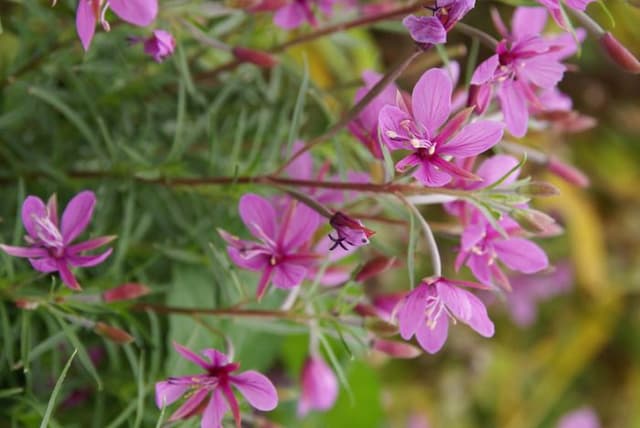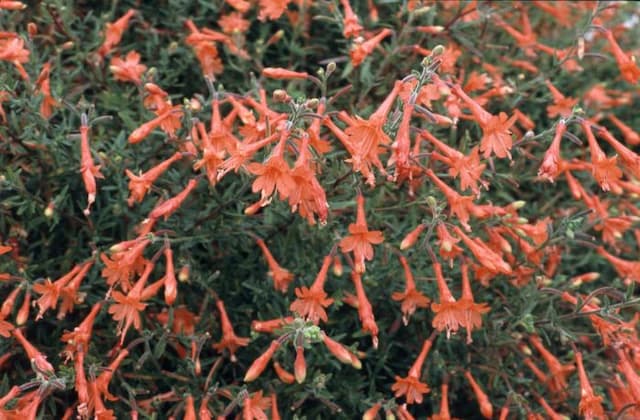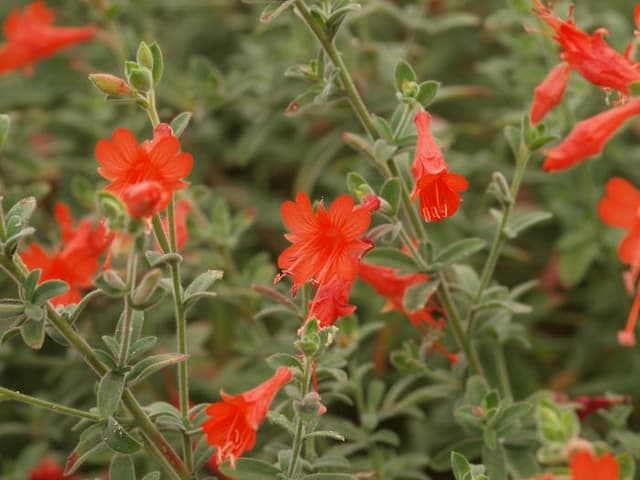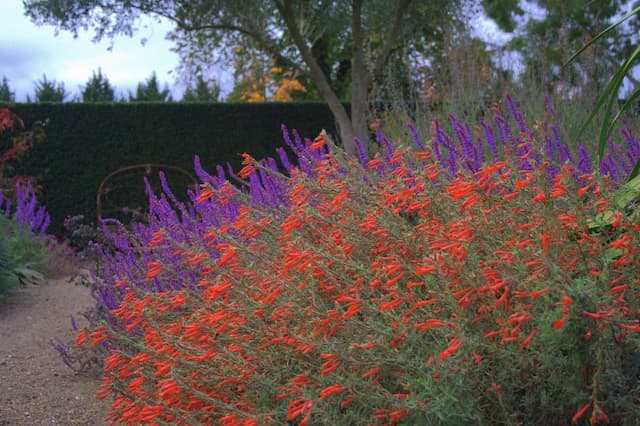Fuchsia Fuchsia 'Madame Cornélissen' (d)
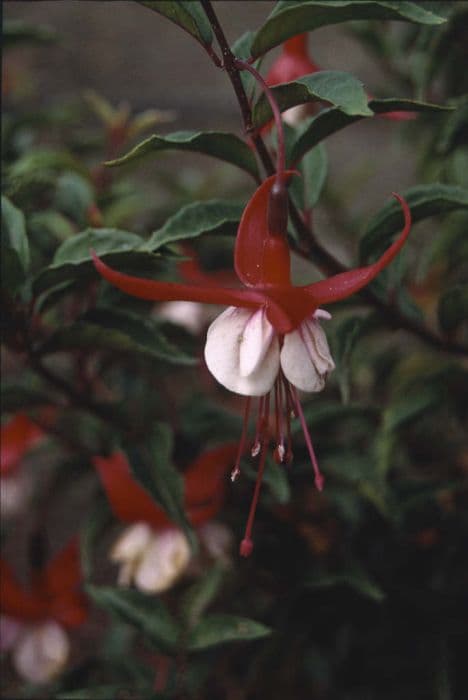
ABOUT
Fuchsia 'Madame Cornélissen' is a strikingly ornate plant, featuring a cascade of pendulous, teardrop-shaped flowers. These blossoms are characterized by their exquisite dual-color scheme: the outer petals are usually a creamy, soft white, presenting a stark contrast to the richly hued inner petals which exhibit a luminous pink to purplish-red tinge. The inner petals gracefully unfurl from the center of the bloom, often curling at the edges and creating an elegant display that is reminiscent of a ballerina's tutu in full twirl. The foliage of the Fuchsia 'Madame Cornélissen' provides a lustrous backdrop to the vivacious flowers. The leaves are typically a lush green with a faint glossy sheen, coupled with a slight texture that feels pleasant to the touch. Each leaf is narrowly shaped, having a slight taper towards the end with a subtle serration lining the edges, forming a gentle contrast to the softer floral aspects. The overall appearance of Fuchsia 'Madame Cornélissen' is one of grace and vibrant beauty, its contrast between the poised leaves and the flamboyant blooms creating a rich visual symphony. This plant is a popular choice for gardeners and plant enthusiasts who wish to add a touch of dramatic flair to their floral displays, without overwhelming the senses with sheer size.
About this plant
 Names
NamesFamily
Onagraceae
Synonyms
Lady's Eardrops, Fuchsia
Common names
Fuchsia 'Madame Cornelissen'
 Toxicity
ToxicityTo humans
Fuchsia, including the variety 'Madame Cornélissen', is generally considered non-toxic to humans. There are no well-known toxic effects or serious consequences associated with ingesting parts of this plant. However, as with any non-food plant material, individual sensitivities may occur, and ingesting plant material is not advisable.
To pets
Fuchsia, including the 'Madame Cornélissen' variety, is generally considered non-toxic to pets as well. It is not known to cause serious poisoning if pets ingest parts of the plant. Although the plant is not toxic, pets may experience mild gastrointestinal upset if they consume large amounts of the plant material. It is still recommended to prevent pets from ingesting plants to avoid any potential issues.
 Characteristics
CharacteristicsLife cycle
Perennials
Foliage type
Deciduous
Color of leaves
Green
Flower color
Mixed
Height
1-2 feet (30-60 cm)
Spread
1-2 feet (30-60 cm)
Plant type
Shrub
Hardiness zones
9
Native area
Central and South America
Benefits
 General Benefits
General Benefits- Enhances Garden Aesthetics: Known for its attractive pendant flowers, this fuchsia variety adds a splash of color and elegance to gardens and landscapes.
- Attracts Pollinators: The vibrant blooms attract bees, butterflies, and hummingbirds, promoting pollination in the garden.
- Versatile Planting: Suitable for containers, hanging baskets, and borders, offering flexibility in garden design and space utilization.
- Shade Tolerant: Thrives in partial shade, making it an ideal plant for cooler, shaded areas where other plants might struggle.
- Long Blooming Period: Produces flowers from late spring to fall, providing prolonged interest throughout the growing season.
- Easy to Propagate: Can be easily propagated through cuttings, allowing gardeners to create more plants for other areas or to share with others.
 Medical Properties
Medical PropertiesThis plant is not used for medical purposes.
 Air-purifying Qualities
Air-purifying QualitiesThis plant is not specifically known for air purifying qualities.
 Other Uses
Other Uses- Living Art: Fuchsia can be trained as a bonsai for creating living art pieces, allowing gardeners to enjoy its miniature beauty in a compact form.
- Fairy Gardens: Due to its delicate and colorful appearance, Fuchsia is often used to add a touch of whimsy in miniature fairy gardens.
- Photography Backdrop: The vibrant colors of Fuchsia blossoms make for a stunning photography backdrop for macro photography and portraits.
- Educational Tool: Fuchsia plants can be used in classrooms or educational programs to teach about plant growth, pollination, and horticulture.
- Color Dye: Historically, some species of Fuchsia have been used to create a dye for fabrics, although it is not a common practice today.
- Ink Making: The juice from Fuchsia berries has been experimented with for use as a natural ink for writing and drawing.
- Culinary Garnish: Edible varieties of Fuchsia can have their flowers used as a garnish for desserts and salads, adding color and a slight acidic flavor.
- Perfumery: While not common, the scent of some fuchsia flowers could potentially be used in crafting homemade perfumes or scented oils.
- Hummingbird Attractant: Planting Fuchsia in the garden can attract hummingbirds, which in turn helps with pollination and creating a lively garden atmosphere.
- Creative Crafts: Fuchsia flowers can be used in crafting, such as pressing for scrapbooking or creating decorative wreaths and arrangements.
Interesting Facts
 Feng Shui
Feng ShuiThe Fuchsia is not used in Feng Shui practice.
 Zodiac Sign Compitability
Zodiac Sign CompitabilityThe Fuchsia is not used in astrology practice.
 Plant Symbolism
Plant Symbolism- Elegance: The Fuchsia 'Madame Cornélissen' is known for its graceful drooping flowers, often associated with sophistication and beauty.
- Good Taste: With its delicate flowers and rich coloration, fuchsia represents refined preferences and good judgment in aesthetic matters.
- Confiding Love: In the language of flowers, fuchsia may represent trust and confiding love, suggesting a deep emotional connection and an open heart.
- Ambivalence: The dual coloring of the fuchsia flower can symbolize mixed emotions or uncertainty, possibly reflecting a complexity in relationships.
- Vibrancy: Known for its vivid hues, this plant often symbolizes vibrancy and joyfulness, celebrating the fullness and energy of life.
 Water
WaterFuchsias, including Madame Cornélissen, prefer to be kept consistently moist, but not sodden. It's crucial to water them when the top inch of soil feels dry to the touch, which typically means watering them about two to three times a week, depending on the weather and humidity levels. During the growing season in spring and summer, you may need to water more frequently, especially if they are in containers. An average requirement might be about 1/2 gallon for a medium-sized pot every few days, but always check the soil before watering to avoid overwatering. In winter, reduce watering to once a week or less as fuchsias require less moisture during their dormant period.
 Light
LightFuchsias, such as Madame Cornélissen, flourish in bright, indirect light. They should be placed in a location where they can receive morning sunlight and afternoon shade, as harsh midday sun can scorch their leaves. A north- or east-facing window would be an ideal spot for indoor fuchsias. If grown outdoors, ensure they are situated beneath a canopy of trees or a similar shelter that protects them from hot sun during peak hours.
 Temperature
TemperatureMadame Cornélissen, like other fuchsias, prefers cooler temperatures, ideally between 55 and 75 degrees Fahrenheit. They can tolerate a range from 40 to 85 degrees Fahrenheit, but extreme temperatures either below or above this range can cause stress and damage. However, to ensure vitality and continued flowering, strive to keep them in their optimal temperature range as much as possible.
 Pruning
PruningPruning is essential for Madame Cornélissen fuchsias to maintain plant shape, encourage bushier growth, and stimulate more flowers. They should be pruned in late winter to early spring before new growth begins. Remove any dead or weak branches and cut back about one-third of the previous year's growth to promote new shoots. Also, throughout the growing season, deadheading spent flowers and pinching out tips can enhance the plant's appearance and encourage further blooming.
 Cleaning
CleaningAs needed
 Soil
SoilFuchsia 'Madame Cornélissen' prefers a well-draining potting mix with peat moss, perlite, and compost to retain moisture and provide nutrients. A slightly acidic to neutral pH, ranging from 6.0 to 7.0, is ideal for this fuchsia variety.
 Repotting
RepottingFuchsias, including 'Madame Cornélissen', should typically be repotted every two to three years or when they outgrow their current pot to ensure healthy growth and adequate room for root development.
 Humidity & Misting
Humidity & MistingFuchsia 'Madame Cornélissen' thrives best in moderate to high humidity levels, ideally around 60-70%. Mist the plant regularly or set it on a pebble tray with water to increase ambient humidity if required.
 Suitable locations
Suitable locationsIndoor
Keep in bright, indirect light and maintain high humidity for fuchsia indoors.
Outdoor
Place in partial shade, shelter from wind, and keep soil moist outdoors.
Hardiness zone
6-11 USDA
 Life cycle
Life cycleFuchsia 'Madame Cornélissen' begins its life as a seed, planted in a warm and moist soil environment to germinate. Once the seedling emerges, it enters a growth phase, forming a bushy habit with vibrant green foliage. As the plant matures, it develops distinctive teardrop-shaped buds that blossom into the iconic pink and purple flowers. After flowering, the plant produces small fruit if pollination occurs, which contain seeds for the next generation. To sustain its life cycle, Madame Cornelissen enters a period of dormancy in cold climates, losing leaves and going into a state of rest to survive the winter. With the return of warmer temperatures and increased daylight, the plant awakens from dormancy, and the growth cycle begins anew with fresh foliage and renewed flowering.
 Propogation
PropogationPropogation time
Spring-Early Summer
Propogation: Fuchsia 'Madame Cornélissen', commonly known as Fuchsia, is best propagated through softwood cuttings. This is typically done in late spring or early summer when the plant's growth is most active. You would take a cutting of about 2 to 4 inches (5 to 10 centimeters) long, making sure it has a few leaves. The bottom set of leaves should be removed and the cut end dipped in rooting hormone powder to encourage root growth. This cutting is then planted in a moist, well-draining potting mix and covered with a plastic bag or placed in a propagator to maintain high humidity levels. It’s important to keep the cutting out of direct sunlight to prevent wilting. With proper care, the cuttings will root in a few weeks, after which they can be transplanted into individual pots.
